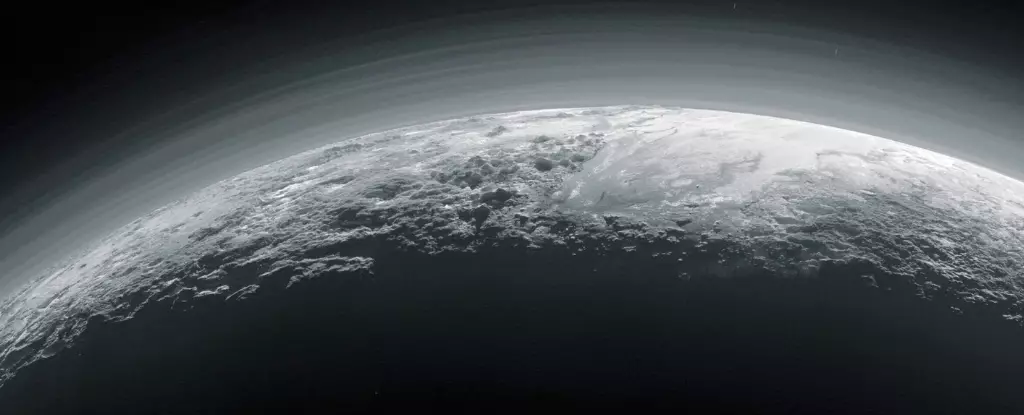In 2015, the New Horizons spacecraft made its historic journey past Pluto and its moon Charon, unveiling a treasure trove of scientific revelations about these distant worlds. This moment marked a pivot in our understanding of the Solar System, particularly Pluto, which had long been shrouded in mystery. For years, astronomers could only speculate about its composition and atmospheric dynamics. Fast forward to the present, new observations taken by the James Webb Space Telescope (JWST) have transformed our perception of Pluto’s atmospheric complexity, suggesting it is unlike any other celestial body in our Solar System.
Pluto’s Distinctive Atmospheric Composition
The latest findings reveal that Pluto’s atmosphere is primarily composed of nitrogen, methane, and carbon monoxide—elements that interact in fascinating ways. What sets it apart from other planetary atmospheres is the presence of haze particles that actively influence its thermal dynamics. This unique haze exhibits an intriguing behavior, rising and falling in response to temperature changes, a phenomenon that has not been observed elsewhere in our Solar System. This characteristic highlights the peculiarities of Pluto’s environment and underscores the need for ongoing investigation.
Astronomer Xi Zhang, whose innovative theories laid the groundwork for these observations, proposed a bold hypothesis in 2017. He predicted that if Pluto’s haze cooled its atmosphere, the haze should emit strong mid-infrared radiation detectable by advanced telescopes. This hypothesis, once deemed audacious, has since been validated by the observations obtained from the JWST, revealing the atmospheric intricacies that New Horizons could only begin to explore.
The Role of Haze in Energy Balance
One of the most remarkable aspects of Pluto’s atmosphere is how haze particles govern the radiative energy equilibrium—essentially the balance of incoming solar energy and how much heat is lost to space. While other planets rely on gas molecules in their atmospheres to manage this energy balance, Pluto appears to operate on a different level. The haze particles dominate this dynamic, making Pluto an anomaly among planetary atmospheres and presenting a unique opportunity for scientists to delve deeper into understanding atmospheric behaviors under extreme conditions.
The data gathered by JWST has demonstrated that this atmospheric activity is not static but rather an ongoing experiment involving nitrogen and methane photochemistry. These insights compel scientists to rethink atmospheric models, particularly as they relate to how such systems evolve over time.
New Insights from the James Webb Space Telescope
The JWST’s observations in 2022 and 2023 focused exclusively on unveiling the atmospheric secrets of Pluto. Specifically, with the MIRI instrument, scientists measured thermal emissions across a spectrum of wavelengths, providing a detailed view of both Pluto and Charon. Comparisons of these measurements with thermal models have yielded crucial constraints on various parameters, such as thermal inertia and emissivity. These metrics guide our understanding of how heat moves within these distant worlds, influencing the distribution of ice across Pluto’s surface and its intriguing interactions with Charon.
Interestingly, the data suggest that seasonal cycles play a pivotal role in the migration of volatile ice deposits across Pluto. This dynamic could result in ice being displaced not just across Pluto but also potentially deposited onto Charon, a phenomenon that seems to have no parallel elsewhere in the Solar System.
Implications for Earth’s Early Atmosphere
Zhang articulates the significance of these findings, positing that the exploration of Pluto’s atmosphere could unlock valuable insights into the conditions that facilitated the emergence of life on early Earth. The atmospheric composition, rich in nitrogen and hydrocarbons, shares similarities with what scientists hypothesize characterized Earth’s primitive atmosphere. Understanding the complexities of Pluto’s haze could illuminate pathways for habitability that once existed on our home planet, thus bridging the gap between our past and present.
A New Era in Planetary Science
The revelations from the JWST pave the way for an exciting chapter in planetary science, one in which Pluto serves as a key to unraveling atmospheric mysteries beyond the icy frontier of the Solar System. The exploration of this enigmatic world encourages further questions about how celestial bodies interact within their unique environments. Moreover, lessons gleaned from Pluto could extend beyond our immediate neighborhood, hinting at the atmospheric phenomena on moons like Neptune’s Triton and Saturn’s Titan, which share similar compositions.
As we stand on the cusp of further discoveries, Pluto continues to captivate our imagination, challenging our preconceived notions about planetary atmospheres and the dynamics governing them. The quest to understand this distant dwarf planet has just begun, inviting inquisitive minds to engage with the scientific dialogue that will undoubtedly shape our understanding of the cosmos for years to come.

